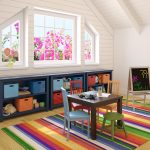One of the things that people consistently say gets in the way of making art is not having an art space. If it’s important to you, though, you can find a way to make it happen!
Many artists struggle to find the space they need to create. Whether you’re working from a small corner of your bedroom or from a dimly-lit basement, a cramped space can often have a negative impact on your creativity and productivity. Having your own home art studio might sound unattainable, but it doesn’t have to be. Creating a dedicated creative space can be surprisingly inexpensive and easy to set up almost anywhere. To help you get started, we’ve put together this breakdown of the things you’ll need to consider in order to set up the perfect space for you and your process. Here are some ideas for creating a fun, funky, and functional art space you can really use in your home.
The easiest way to accomplish this is to divide or dual-purpose a room into living space and art studio space. You could use shelving, a table, or a screen to delineate the art area in a family room or living room. Even better, your new art studio could be as close as your current bedroom, if you convert your bed to a Murphy bed! Pull it down to sleep, and securely fold it away in the morning to reveal completely open floor space for creating.
You could consider taking over the garage, attic, or basement. But be sure to consider heating, cooling, and humidity issues that could have a negative impact on your productivity and your art.
Whether carving out a dedicated art space in your home feels impossible, or you like being able to make art anywhere, a portable art kit is an essential tool. We’ve been fans of using pouches and canvas rolls as portable art kits for some time. You could also make a rolling art cart to create an art space anywhere at home.
Finally, consider your light source in the space. You might think natural light is ideal for an art studio, but it isn’t always the best choice. Natural light changes throughout the day, both with intensity and direction. This can lead to a false sense of color in your work and your canvases might look completely different in another setting such as a gallery or a client’s home. However, if your room does have windows, it’s best if they’re north-facing if you’re in the northern hemisphere, and south-facing in the southern hemisphere. This way, the light will fluctuate less throughout the day.
Artificial light gives you more control over your studio’s setting and it’s important to have consistent, bright lights that flood the entire room. Rather than standing lamps and spotlights that will only illuminate part of your work, a light panel mounted on the ceiling is the best choice.





